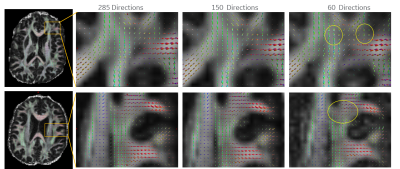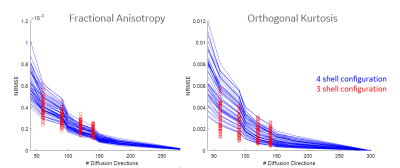Nastaren Abad1, Luca Marinelli1, Radhika Madhavan1, James Kevin DeMarco2, Robert Y Shih2,3, Vincent B Ho2,3, Gail Kohls2, and Tom K.F Foo1
1General Electric Global Research, Niskayuna, NY, United States, 2Walter Reed National Military Medical Center, Bethesda, MD, United States, 3Uniformed Services University of the Health Sciences, Bethesda, MD, United States
1General Electric Global Research, Niskayuna, NY, United States, 2Walter Reed National Military Medical Center, Bethesda, MD, United States, 3Uniformed Services University of the Health Sciences, Bethesda, MD, United States
To establish a benchmark for future studies this study utilized a data
driven approach for optimizing diffusion sampling for high-performance
gradients, focusing on b-value and noise performance on uncertainty in tensor estimates & fiber orientation to resolve sub-voxel information.

Figure
5. fODFs over two slices highlight exemplary insets as # directions is uniformly
decreased. Interestingly, at half the sample size of the superset, the
principal component is retained. Even with the sample size scaled to a 1/4th
of the original dataset, the principal component is retained, though, a slight
uptick in noise is evident in the fiber crossing and interfacial regions. (“noisy”
lobes: yellow circles).

Figure
4. Normalized root mean square error (NRMSE) over 76 WM bundles for FA and
Orthogonal Kurtosis highlighting bias developed as # directions sampled is decreased. As
is evident, the NRMSE for both FA and kurtosis grows more slowly, indicating
stability compared to the standard, however, past 90 directions, the sqrt(N)
scaling factor breaks down for both measures albeit the bias is not at the same
scale. Interestingly, with uniform sampling over a 3-shell configuration, the
bias in metrics can be reduced. Note the y-axis scale for FA and Kurtosis is
not the same